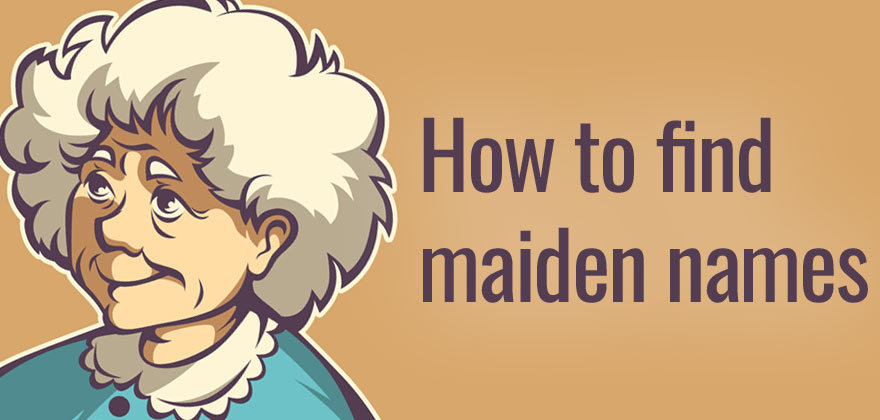Finding a maiden name of a female ancestor can lead to a dreaded brick wall that every family historian will encounter. All of the women in our family tree had families and lives before they married – but often, we can only find records detailing their lives as “Mrs. John Smith.”
Without knowing an ancestor’s maiden name, locating information on her early life and family can seem impossible.
So, how do you find someone’s maiden name? Learning where and how to look for clues in our ancestor’s records can help any researcher easily conquer this brick wall and add a new branch to their family tree!
Pro tip: vital records are the best place to find maiden names. Birth records can include a mother’s maiden name. Marriage records can list the maiden name of the bride as well as her parent’s names. Death records can list the decedent’s parents’ names. Locate these records first.
Our female ancestors
In order to locate your missing female ancestor’s family name, it is vital to understand the world in which she lived. Prior to the 20th century, women’s identities were largely tied to their husbands, father, or brothers- men who would make the major household decisions.
Women were prohibited from participating in many daily activities, including purchasing or owning land, signing legal documents, exercising their right to vote, or engaging in occupations outside the home. Due to their restrictive lives, women tend to be “missing” from many genealogical records and sources.
Making an effort to learn more about the time period and place in which your ancestor lived can provide clues about what kinds of records she may be found in, and add historical context to bring your ancestor’s story to life.
For example, the National Archives Prologue magazine has an informative article about women and naturalization laws from 1802-1940, which can help you determine how or if your immigrant ancestors naturalized.
Read next: How to Find Naturalization Records
It is vital to learn what genealogical records are available in the town, county, and state where your ancestor lived. Did the county courthouse suffer a fire that may have destroyed your ancestor’s birth or marriage records? Were any records microfilmed, and are they available online or through a repository? Visiting the FamilySearch Research Wiki is a good way to start learning more about historical records in your research area.
Research tips
Here are a few research techniques that will help uncover clues to shed light on your ancestor’s life:
Using the FAN principle
Genealogist and author Elizabeth Shown Mills coined the phrase “FAN Club,” where FAN stands for Family, Associates, and Neighbors. Make a list of the people that lived and associated with your ancestor:
Who else is living with your ancestor in census records or city directories? What is their stated relationship? Who is traveling with your ancestor to America according to the passenger manifest?
What other family members are mentioned in wills and probate records? Who is mentioned in birth records, marriage or obituary announcements placed in the local newspaper?
This category can include friends, acquaintances, or business partners. Who did your ancestor or her husband transact land with- and might that person be related to your ancestor’s family?
Check newspapers for the local social/gossip column- was your ancestor involved in her local bridge club or women’s church group? Who participated with her? Might they be cousins or other members of her family?
Very often, especially in rural areas, families lived near each other- so the in-laws may have been down the road. Flip through the census pages before and after the one on which your ancestor is listed- do any names occur several times or sound familiar?
Similarly, look at land transactions in your ancestor’s township and the surrounding area- often, land was sold between family. Who else attended the local church with your ancestor?
Use a chart to keep track of names, places, and dates
Create a chart to track the names you find using the FAN principle. This will help ensure that nothing important is missed. Creating a timeline of when and where your ancestor interacted with these people will help paint a bigger picture of her life and may reveal a new clue to her family tree.
Try working backward
Rather than research from the beginning of your ancestor’s life, try working backward by starting with her death. Look for supporting records – a death certificate, cemetery records, or obituary notice. What information is provided in these records?
A death certificate may list parents’ names, and an obituary often lists family members. Your ancestor may be buried in her family plot, or buried nearby a family plot, in the local cemetery.
Try a different way to search online
Sometimes, conducting a search in databases such as Ancestry or FamilySearch WITHOUT using a surname can yield surprising results. If you know approximately when and where your ancestor was born, or other identifying information, try searching with that information, using her first name only.
There may have been many “Janes” born in Ohio between 1870 and 1875, but far fewer “Janes” born in Ashtabula, Ohio in January 1873, with sisters named Sue and Mary. With any luck you may find Jane, Sue and Mary in the 1880 census, maiden names and all!
Research the FAN Club to turn up new clues
If you are not having any luck finding records for your ancestor, then start researching the people on the FAN list. Perhaps your ancestor did not have any parents listed on her death certificate – but her siblings may have mom and dad’s names on their own death records.
Similarly, look at your ancestor’s children- her son or daughter might have provided their mother’s maiden name on their own marriage records.
Additionally, family naming patterns might reveal clues. A woman’s maiden name is sometimes used as a first or middle name for one of her children- for example, John Smith and Mary (Lansford) Smith have a son named Lansford Smith. Broadening your research beyond your target ancestor is vital.
Types of records
Here is a list of common types of records that may reveal information about an ancestor’s maiden name and family, to help ensure that an important recordset is not overlooked. This list goes beyond the standard vital records that most people look for.
Marriage records
Marriage license
This is usually the application form filled out by the bride and groom, where the bride would provide her maiden name along with other identifying information. Be aware of any previous marriages for the bride- she may have provided her previous married name, and not her maiden name.
While mistakes and typos have been known to happen, information on a marriage license is generally considered reliable as it is provided by the subjects themselves, and not by a secondary source.
Marriage certificate
Check the name of the person who performed the marriage- this might give you a clue as to whether the couple was married by a religious official or by a justice of the peace. If married in a religious ceremony, you can then look for church records. Witnesses are another vital clue- did a family member of the bride witness the event?
Newspaper announcements
If you know where the bride and/or groom were born, check the local papers for engagement and wedding announcements. Engagement announcements may have occurred a few weeks to a few months prior to the wedding, perhaps longer. Lucky researchers may even find a photograph of the happy couple in the local paper’s Social Events section!
Church marriage records
If the couple’s religious denomination is not known, research the name of the officiant who signed the marriage certificate; he was likely a local pastor, rabbi or priest. A church marriage record book often lists witnesses to the event. This may be the bride’s family church, so finding her in the local church records might yield further clues to her upbringing and family members who attended that church.
Divorce records
Did your ancestor re-marry? Don’t always assume she was widowed. Determining her prior husband’s date of death can clue you into this possibility. Checking for divorce records in the local county court may turn up surprising results.
Additional church records
Beyond marriage records, look for birth or baptismal records for your ancestor’s children, or even her siblings. Godparents or witnesses might be listed, who are often family members.
Death records
As stated above, working backward through the records can often be helpful.
Social Security Death Index, Applications and Claim
If a woman applied for Social Security, the application required several pieces of identifying information, including father’s name and mother’s maiden name.
Click here to search theses indexes on Ancestry.com.
Additionally, name changes were also included in the application, so if your ancestor married or re-married, her maiden name or previous name may be found here. Be aware, however, that parents’ names are not available to view online unless the deceased would be 75 years or older today.
If your ancestor did not apply for Social Security, check to see if her children did, as their Social Security applications should include their mother’s maiden name.
Cemetery records
If you know where your ancestor is buried, check for family plots within the same cemetery. In particular if you know your ancestors were of the same faith –for example, Catholic- check the local Catholic cemeteries and see if any names sound familiar.
Obituaries and funeral notices
Sometimes your ancestor may only have a brief funeral notice- but even a small announcement like this can provide information as to when and where she was buried. Obituaries are often a goldmine of information (if you can find them).
Census records and city directories
Perhaps your ancestor’s home was also home to one or more of her family. Keep track of who lived with her through the years- a woman often cared for an aging parent, or a younger, unmarried sister may have moved in to help with young children.
Military pension records
This is an often overlooked, but potentially valuable recordset. First, research your ancestor’s male relatives to determine if they may have served in the military.Then check if that soldier may have received a pension.
Pension records often contained family information, and sometimes include birth, marriage and death records. Some pension records are available to research online, but others may require further action. The National Archives can help you get started.
Land records
Your ancestor may have been allowed to own property in the area where she lived- be sure to research local law history. Or, her husband may have bought or sold land from one of her male relatives.
Wills and probate records
If your ancestor did own property, she may have prepared a will. Look for names of siblings, nieces or nephews that may have inherited land or other items from her.
Family keepsakes
Heirlooms kept by your ancestor’s descendants may be the richest and best source of information on her family. If you are able to get in contact with a family member, perhaps they have a family bible, old letters, legal documents, newspaper clippings, or photographs that they are willing to share.



Every one of your articles is so full of information, ideas, and tips that are practical and so useful! Thank you!
Thanks for all the good ideas. I have been researching my family for 60 years and I’m learning new things all the time.